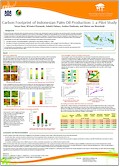| Poster |
 |
|
| Title | Carbon Footprint of Indonesian Palm Oil Production: I. a Pilot Study | | Author | Sonya Dewi, Ni'matul Khasanah, Subekti Rahayu, Andree Ekadinata and Meine van Noordwijk | | Year | 2010 | | Publisher | World Agroforestry Centre - ICRAF, SEA Regional Office | | City | Bogor, Indonesia | | Purpose | Science Forum 2010 | | Call Number | PO0236-10 |
|
| Abstract: |
In the last five years Indonesian palm oil production grew by 13.41% per year, with growth in export at 16.24% per year and slow growth in domestic consumption. Oil palm production in Indonesia and Malaysia is now in the focus of the debates on Biofuel and Carbondioxide (CO2) and other greenhouse gas (GHG) emissions, through its association in the public debate with deforestation and (over)use of peatland. The potential use of palm oil as biodiesel to reduce dependency on, and emissions from, the use of fossil fuel has focused debate on the emissions caused by the conversion of land to oil palm and subsequent steps in the production.
Carbondioxide (CO2) and other GHG emissions can be attributed to three phases of the production process:
a. the initial conversion of preceding vegetation, usually based on 'land clearing', leading to a 'C debt‘,
b. the balance of emission and absorption during the growth cycle of the oil palms, leading to a time-averaged C-stock that influences 'C debt' and repay time,
c. transport to the refinery followed by CPO and kernel production, transesterification into biofuel and further transport to the end users.
A comprehensive accounting system on carbon and other GHG emissions of biofuel production of oil palm has to include the whole life cycle assessment (LCA) through a life cycle inventory (LCI) (ISO, 1997). |
|
|
Download file(s): Click icon to download/open file.
|
| |
File Size |
Description |

|
1,297 KB |
Softcopy |
|
|
GRP 6: Developing policies and incentives for multifunctional landscapes with trees that provide environmental services
|
| Viewed in 2345 times. Downloaded in 1190 times. |